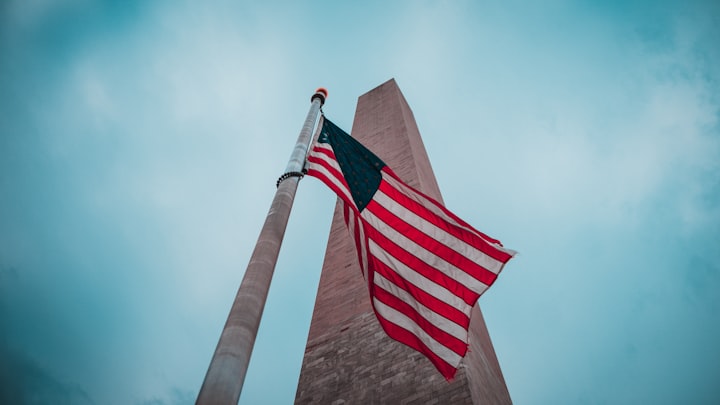One Man’s Radical Plan to Blow Up the Washington Monument
Norman Mayer had one goal in mind and formed a plan to make it happen

Some live with an ambition of going out in a blaze of glory. Others don’t really care how their death takes place as long as it brings attention to their cause or their beliefs.
Norman David Mayer dreamed of both.
The World’s Attention Turns to the Washington Monument
At 9:20 a.m. on December 9, 1982 a white van parked at the base of the 555-ft Washington Monument in Washington, D.C. Out of it steps a man wearing a black motorcycle helmet, a blue snowsuit, and a backpack with a two-foot antenna protruding from it. In his hands was some type of remote-control device and on the side of the van was a sign that read:
“No.1 Priority, Ban Nuclear Weapons”
He made but a single demand: the issue of banning nuclear weapons must be “the first business on every agenda of every organization” in the country.

Visitors of the monument reported that the man, who was later identified as Norman David Mayer, stated that he "had a lot of dynamite in the truck" and that if anyone came near it, he would blow them up. Mayer then approached one of the park rangers and instructed him to clear the monument before he detonated the explosives. He provided the ranger with a piece of paper with a handwritten message:
"If any person starts up this hill, the government agencies will be responsible for the consequences.
№1 priority: Will only negotiate with a representative of the media.
"Let the Washington, D.C. (U.S.A) media form an ad hoc committee and vote a single person without dependents to intermediate."
He claimed that the truck was loaded with over 1,000 pounds of explosives.
It didn't take long for the area to be filled with law enforcement vehicles, fire trucks, ambulances, a special weapons team, and an armored vehicle.
Authorities immediately began evacuating nearby roadways and buildings, including the Washington Mall, the Commerce and Agriculture Department office building, and the Smithsonian Institution's National Museum of American History. It even caused tightened security at the White House, six blocks north of the monument. President Reagan was moved from the State Dining Room where he and his special panel on private sector initiatives were meeting. It was feared that if the bomb exploded that it would shatter the windows.
Unfortunately, there were nine tourists who were unable to be evacuated, and were trapped in the monument for five hours of the ten-hour ordeal.
Mayer's 15 Minutes
Mayer made it very clear that he would only speak with a member of the news media. Out of the crowd stepped young, local Associated Press Reporter Steve Komarow. Komarow was eventually allowed to approach Mayer and the van after showing that he was unarmed. Even though he was not a trained negotiator, his main concern was getting the suspect to release the hostages still inside the Washington Monument. Around 2 p.m., Mayer agreed. The hostages were released unharmed.

Komarow stated: "As I stood near the white van, there was no way for me to know whether this man posed a real threat of massive destruction.''
To make matters worse, the motorcycle helmet that Mayer was wearing obstructed his face from view. Komarow couldn't read Mayer's facial expressions to determine how the conversation between the two of them was influencing the suspect.

Komarow spoke with Mayer several times over the course of the day and then reported back to negotiators. He described Mayer's demands as "largely unfocused". However, there was one element of Mayer's intent that was clear; he insisted that every country in the world give up their nuclear weapons. While this most recent action was the most extreme, this was not a new mission for him. For Mayer, this message encompassed most of his life.
Who Was Norman D. Mayer?
Norman David Mayer was born in 1916 in El Paso, TX. His father died when he was only two. Afterward, his destitute mother moved him and his brother, Aubrey, to New Orleans, where she placed them in an orphanage.
It seems as though Mayer, nicknamed "Buddy", was the rebellious sort from an early age. His brother spoke of Mayer after the Washington incident,
"Buddy was always in trouble. He had broken fingers and casts on his hands from fighting in school. He didn't participate in organized anything . . . Buddy was always more sure of what he thought than I was. He read Marx, Dos Passos and Upton Sinclair and we were influenced by some older young people who were lefties. He was always a beautiful physical specimen. Lay your hands on him and you were in trouble."
After being expelled from the Isadora Newman Manual Training School, a Jewish school that the children from the orphanage attended, Mayer began classes at the Delgado Trade School. Here, he learned to become a tool and die maker. He used his trade to fund his travels around the world. He would work long enough to save up money, travel until it ran out, and then repeat the process.
He mined for gold in Alaska in the 1930s, was drafted by the Navy in 1944, served two years in San Diego as a fireman first class, lived in L.A. for a while, and then set off for Southern Florida. In Miami Beach, Mayer spent his time coming up with "get-rich-quick schemes". He also discovered a self-described "solution" to end the world's food shortage problems and worked on the idea of developing a coconut and plastic building material.

After an arrest for assault and battery in 1957, Mayer found it difficult to find work in Miami and set his sails for the Caribbean. During the 1960s, he worked in the Virgin Islands, Puerto Rico, and Jamaica as a hotel maintenance engineer.
1969 was when Mayer took off to Vietnam as worked as a helicopter machinist. After getting a first-hand glimpse of the war, he made the comment to his friend Jack Bauer, "Where else can you find such opposition that will fight to the death on a handful of rice", referring to the resolve of the Vietcong. He was also appalled by what he claimed was the "murders of innocent Vietnamese".
Mayer then traveled to Singapore, Bombay, Kenya, the Seychelles Islands, and finally Bangkok. In Bangkok, he bought over 44 pounds of marijuana and boarded a plane for Los Angeles, with the intent to sell it and pocket a large profit when he arrived. However, after a tip provided by the Bangkok drug dealer, Mayer was arrested and charged with drug trafficking during a layover in Hong Kong. He spent 10 months in a Hong Kong jail cell.
During his trial, Mayer called some 20 witnesses for his defense, including major Hong Kong law enforcement officials and chemists, who he argued with over the "sex characteristics of marijuana blossoms". This spectacle of a trial lasted 22 days. He was sentenced to three years in prison and was scolded for wasting the court's time.
The judge, Benjamin Liu stated that it was a
"pity that Mayer had not made better use of his "high intelligence and ingenuity."
Mayer then responded to the judge with,
"This is an act of violence and the first act of war between the government of Hong Kong and the government of the United States."
That, and other statements, called for Mayer to be confined in Sui Lam Psychiatric Centre for five months. He then appealed his case based on illegal search and seizure, won, and was deported back to the United States.
Obsession
Once back in the U.S., Mayer quickly became obsessed with nuclear disarmament. He began reading publications such as The Bulletin of Atomic Scientists, as well as mailing out letters and handing out leaflets to scientists, newspaper editors, and the leaders of antinuclear movements.
Mayer moved into a one-room apartment on the roof of the Continental Hotel in Miami Beach where he worked double shifts and saved every dollar he could. In 1981, he bought a used truck, which he claimed could help him survive a nuclear war.
After saying his goodbyes to his friend Jack Bauer, Mayer headed north.
He purportedly asked a reporter in Norton, VA where he could find an explosives carrier stating,
"I thought I might blow something up. Don't you think that would be a good way to get someone's attention?"
He then approached licensed explosives expert, Harold Miller, in Hazard KY.
"He said he wanted 8,000 pounds [of dynamite] or more and he said there was a good hunk of money in it. He offered me $1,000 plus a dollar a pound for every pound that I would buy him," said Miller.
Miller called police, who questioned Mayer. They had to release him as he had not actually purchased any dynamite.
Unsuccessful at acquiring explosives, Mayer began his protests in front of the White House. He spent nearly $5,000 on a $30 a night room at the Downtown Motel in D.C. His funds were running out, as well as his patience. All of his efforts have been in vain and nothing had changed. He would have to do something drastic if he were to get the attention of those in charge.
The Outcome
On December 9, 1982, Mayer pulled his van up to the base of the Washington Monument. During the ten-hour long stand-off, authorities ran the Florida license plate attached to the van and discovered Mayer's identity. They began speaking to his associates and slowly pieced together who they were dealing with. Coupled with the information that Mayer had provided on the scene, they treated the incident as if there were known explosives in the van and that Mayer had the means to detonate them.
The stand-off lasted until about 7:30 p.m. that evening when Mayer entered the driver seat of the van and began to pull away from the monument. At that moment, several sharpshooters opened fire on the vehicle. The truck swerved and then toppled over approximately 50 yards from the monument.
Police cautiously approached the truck after the shooting due to the belief that it contained explosives. Bomb dogs actually showed a positive reaction when they sniffed the vehicle for explosives, furthering their caution.
When authorities reached the vehicle, they found Mayer handcuffed to the steering wheel with gunshot wounds to the arm, the top of the chin, and the left temple. Even though he was close to death, he still maintained his ruse. When asked by Treasury agent W.H. Seals if there were any explosives, Mayer replied
"Yes, I have a thousand pounds".
Those were his last words. Norman Mayer died, as he had suspected he would.
Authorities eventually opened the cargo area of the van, only to find…
Nothing.
There were no explosives.
U.S. Park Police Cpt. Robert H. Hines stated that this was the longest terrorist bluff in U.S. History.
Sources
https://www.nytimes.com/1982/12/09/us/man-slain-in-capital-monument-threat.html
https://www.washingtonpost.com/archive/politics/1982/12/19/the-odyssey-of-norman-mayer-victim-of-an-unyielding-will/db1ab8fb-d12e-4fea-a887-34f873953c8d/
https://www.washingtonpost.com/archive/politics/1982/12/09/monument-is-hostage-10-hours/0c975692-c6b6-47f0-a8ab-035d8bbf1d1e/
***Note: This story was originally published on Medium.com by the author***
About the Creator
Kassondra O'Hara
Working mom who uses her curiosity to fuel the curiosities of others ~ Writes mostly history and true crime






Comments
There are no comments for this story
Be the first to respond and start the conversation.